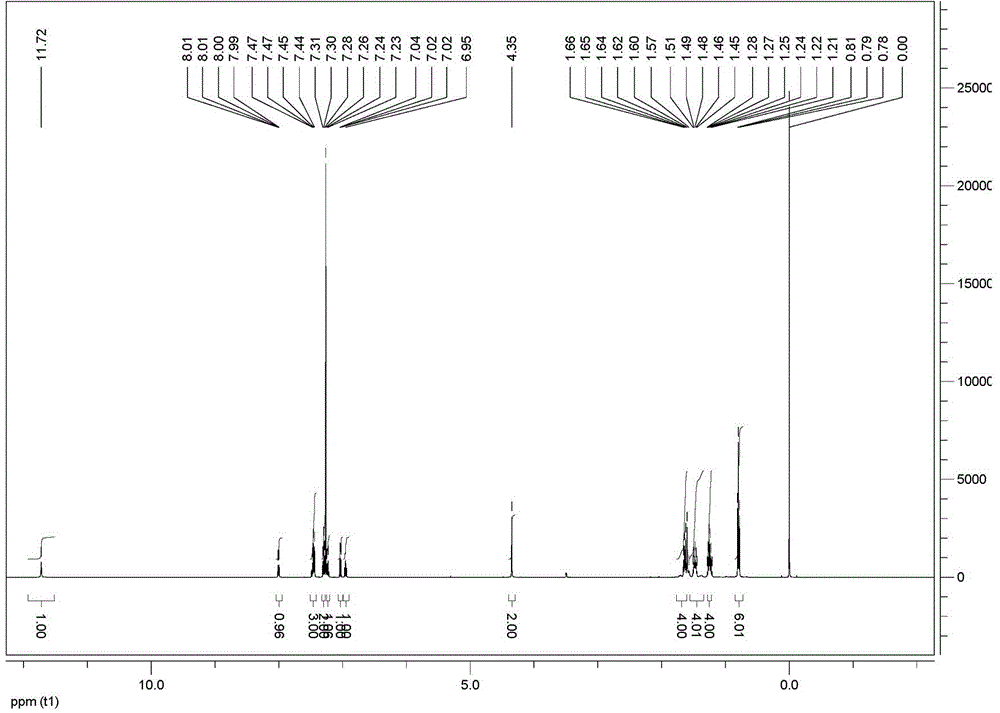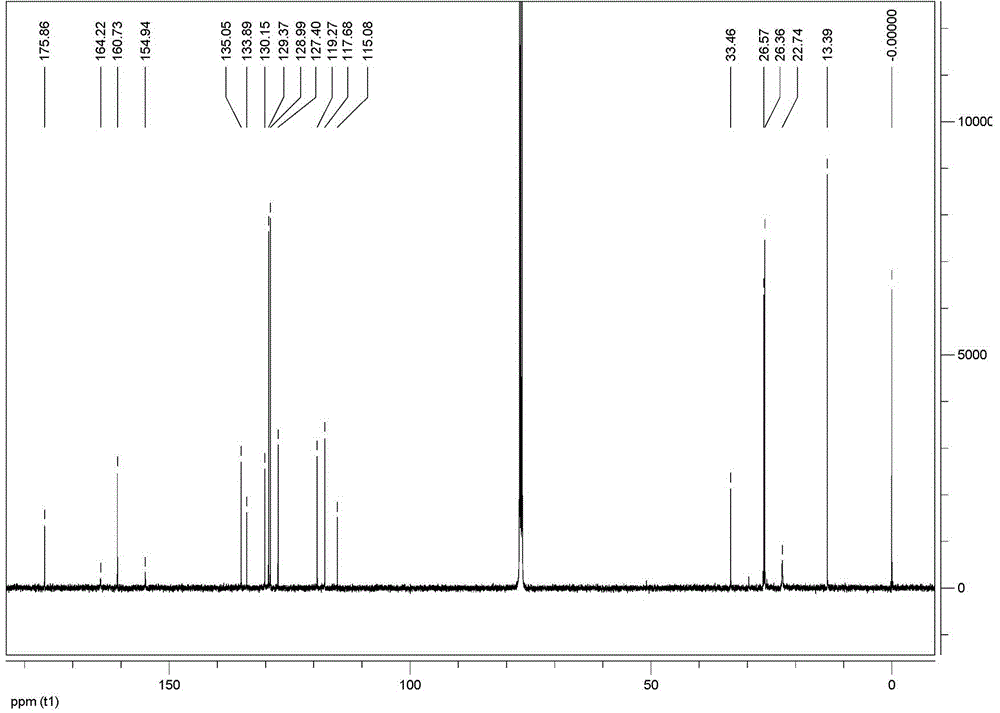2-carbonyl-3-phenylpropionic acid salicyloyl hydrazone di-n-butyltin complex as well as preparation method and application thereof
A technology of di-n-butyltin phenylpropionate salicyloylhydrazone, di-n-butyltin oxide is applied in directions such as tin organic compounds, pharmaceutical formulations, organic chemical methods, etc., can solve problems such as undiscovered compounds, and achieves simple preparation method and low cost Effect of low, good anticancer activity
- Summary
- Abstract
- Description
- Claims
- Application Information
AI Technical Summary
Problems solved by technology
Method used
Image
Examples
Embodiment 1
[0042] Preparation of 2-carbonyl-3-phenylpropionic acid salicylhydrazone di-n-butyltin complex:
[0043] Add 0.249g (1.0mmol) di-n-butyltin oxide, 0.152g (1.0mmol) salicylic hydrazide, 0.205g (1.1mmol) sodium phenylpyruvate and 15mL solvent anhydrous methanol in a 100mL three-necked flask protected by nitrogen. React at a temperature of 45~65°C for 8 hours, cool, filter, and control the solvent volatilization and crystallization at 20~35°C to obtain a yellow transparent crystal, which is 2-carbonyl-3-phenylpropionic acid salicylhydrazone di n-Butyltin complexes. Yield: 83.3%. Melting point: 164~166°C (dec).
[0044] Elemental analysis (C 24 h 30 N 2 o 4 Sn): Calculated: C 54.47, H 5.71, N 5.29; Found: C 54.50, H 5.70, N 5.26.
[0045] FT-IR (KBr, ν / cm -1 ): 3450, 3059, 2960, 2926, 2860, 1616, 1598, 1510, 1490, 1452, 1381, 1323, 1174, 858, 754, 713, 682, 632, 586, 511, 428.
[0046] 1 H NMR (500 MHz, CDCl 3 , δ / ppm): 11.72 (s, 1H), 7.99~8.01 (d, J =7.9Hz, 1H), 7.4...
Embodiment 2
[0051] Preparation of 2-carbonyl-3-phenylpropionic acid salicylhydrazone di-n-butyltin complex:
[0052] Add 0.249g (1.0mmol) di-n-butyltin oxide, 0.152g (1.0mmol) salicylhydrazide, 0.195g (1.05mmol) sodium phenylpyruvate and 35mL solvent anhydrous methanol in a 100mL three-necked flask protected by nitrogen. React at a temperature of 45-65°C for 5 hours, cool, filter, and control solvent volatilization and crystallization at a temperature of 20-35°C to obtain a yellow transparent crystal, which is 2-carbonyl-3-phenylpropionic acid salicylhydrazone di n-Butyltin complexes. Yield: 85.5%. Melting point: 164~166°C (dec).
[0053] Elemental analysis (C 24 h 30 N 2 o 4 Sn): Calculated: C 54.47, H 5.71, N 5.29; Found: C 54.50, H 5.70, N 5.26.
[0054] FT-IR (KBr, ν / cm -1 ): 3450, 3059, 2960, 2926, 2860, 1616, 1598, 1510, 1490, 1452, 1381, 1323, 1174, 858, 754, 713, 682, 632, 586, 511, 428.
[0055] 1 H NMR (500 MHz, CDCl 3 , δ / ppm): 11.72 (s, 1H), 7.99~8.01 (d, J =7.9H...
Embodiment 3
[0060] Preparation of 2-carbonyl-3-phenylpropionic acid salicylhydrazone di-n-butyltin complex:
[0061] Add 0.249g (1.0mmol) di-n-butyltin oxide, 0.160g (1.05mmol) salicylhydrazide, 0.214g (1.15mmol) sodium phenylpyruvate and 25mL solvent anhydrous methanol in a 100mL three-necked flask protected by nitrogen. React at a temperature of 45-65°C for 24 hours, cool, filter, and control solvent volatilization and crystallization at a temperature of 20-35°C to obtain a yellow transparent crystal, which is 2-carbonyl-3-phenylpropionic acid salicylhydrazone di n-Butyltin complexes. Yield: 84.1%. Melting point: 164~166°C (dec).
[0062] Elemental analysis (C 24 h 30 N 2 o 4 Sn): Calculated: C 54.47, H 5.71, N 5.29; Found: C 54.50, H 5.70, N 5.26.
[0063] FT-IR (KBr, ν / cm -1): 3450, 3059, 2960, 2926, 2860, 1616, 1598, 1510, 1490, 1452, 1381, 1323, 1174, 858, 754, 713, 682, 632, 586, 511, 428.
[0064] 1 H NMR (500 MHz, CDCl 3 , δ / ppm): 11.72 (s, 1H), 7.99~8.01 (d, J =7.9...
PUM
 Login to View More
Login to View More Abstract
Description
Claims
Application Information
 Login to View More
Login to View More - Generate Ideas
- Intellectual Property
- Life Sciences
- Materials
- Tech Scout
- Unparalleled Data Quality
- Higher Quality Content
- 60% Fewer Hallucinations
Browse by: Latest US Patents, China's latest patents, Technical Efficacy Thesaurus, Application Domain, Technology Topic, Popular Technical Reports.
© 2025 PatSnap. All rights reserved.Legal|Privacy policy|Modern Slavery Act Transparency Statement|Sitemap|About US| Contact US: help@patsnap.com



